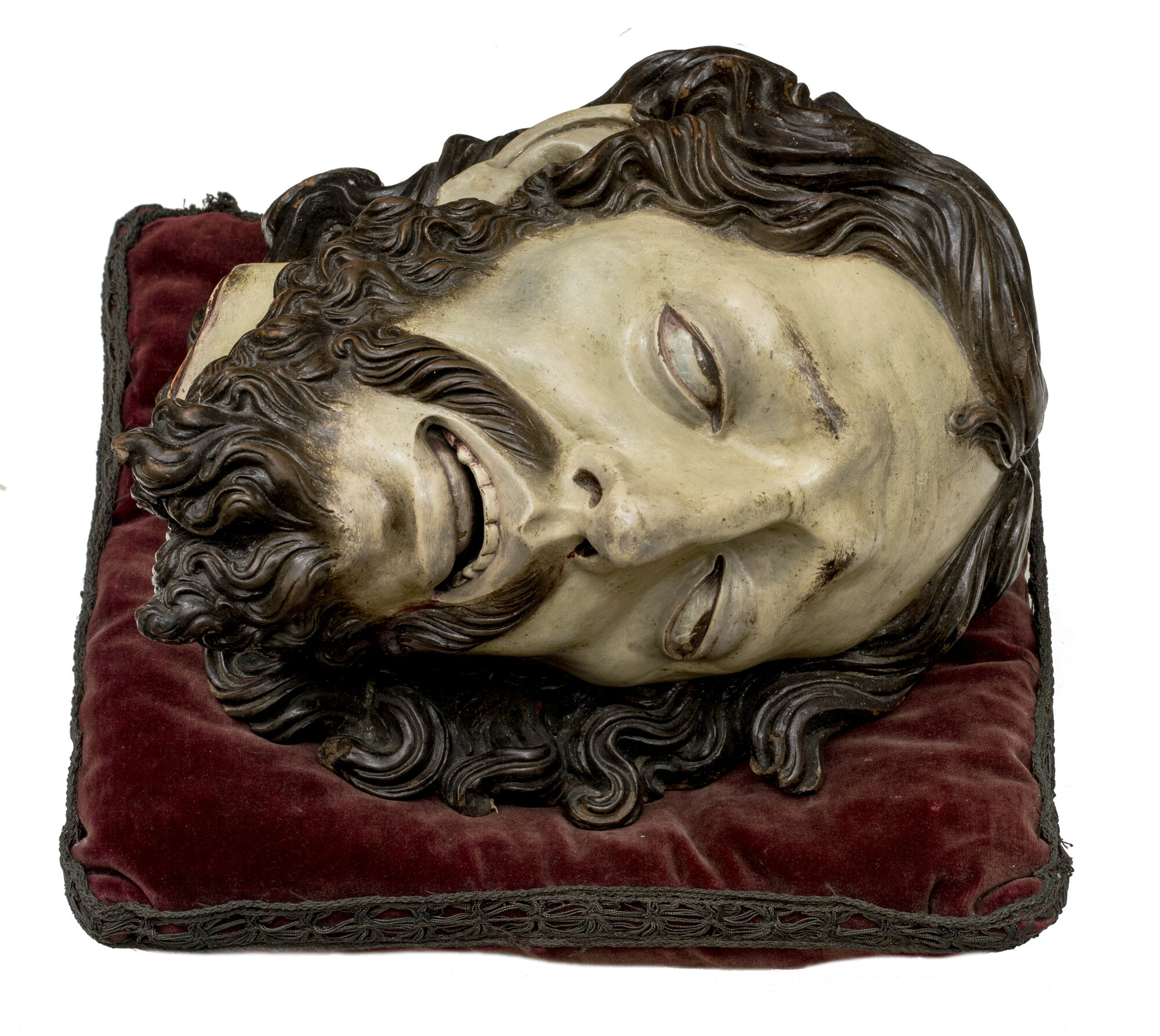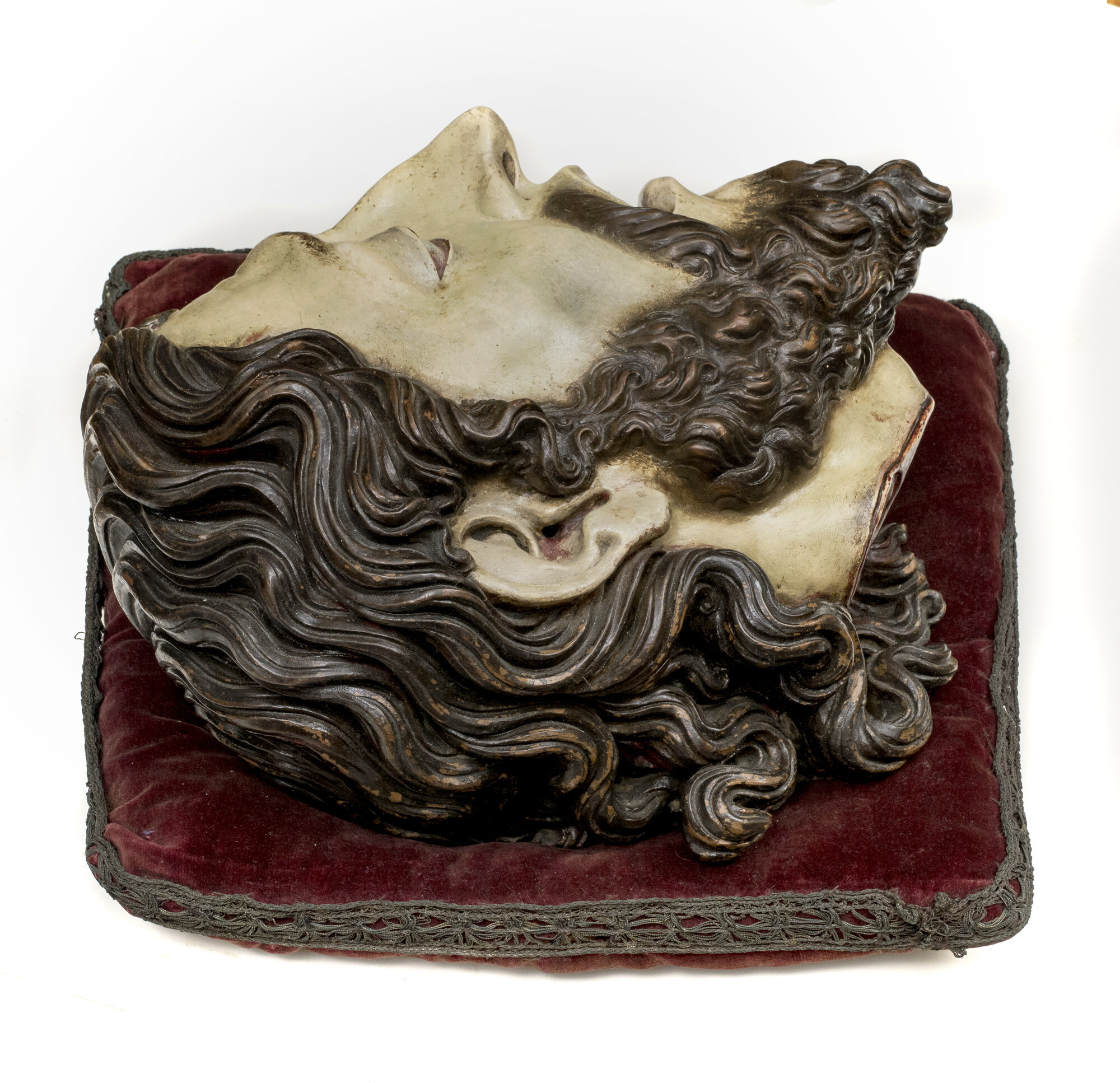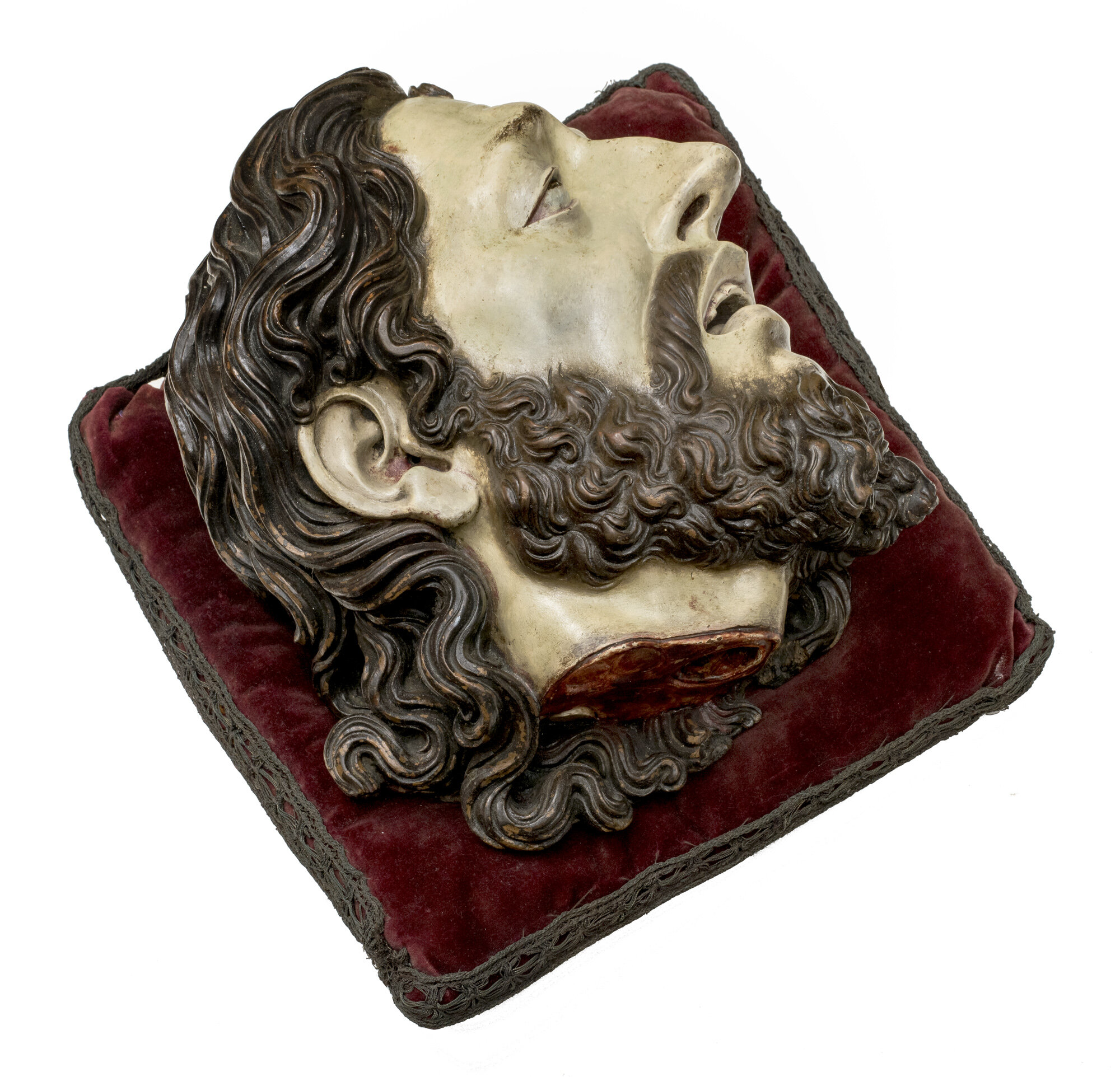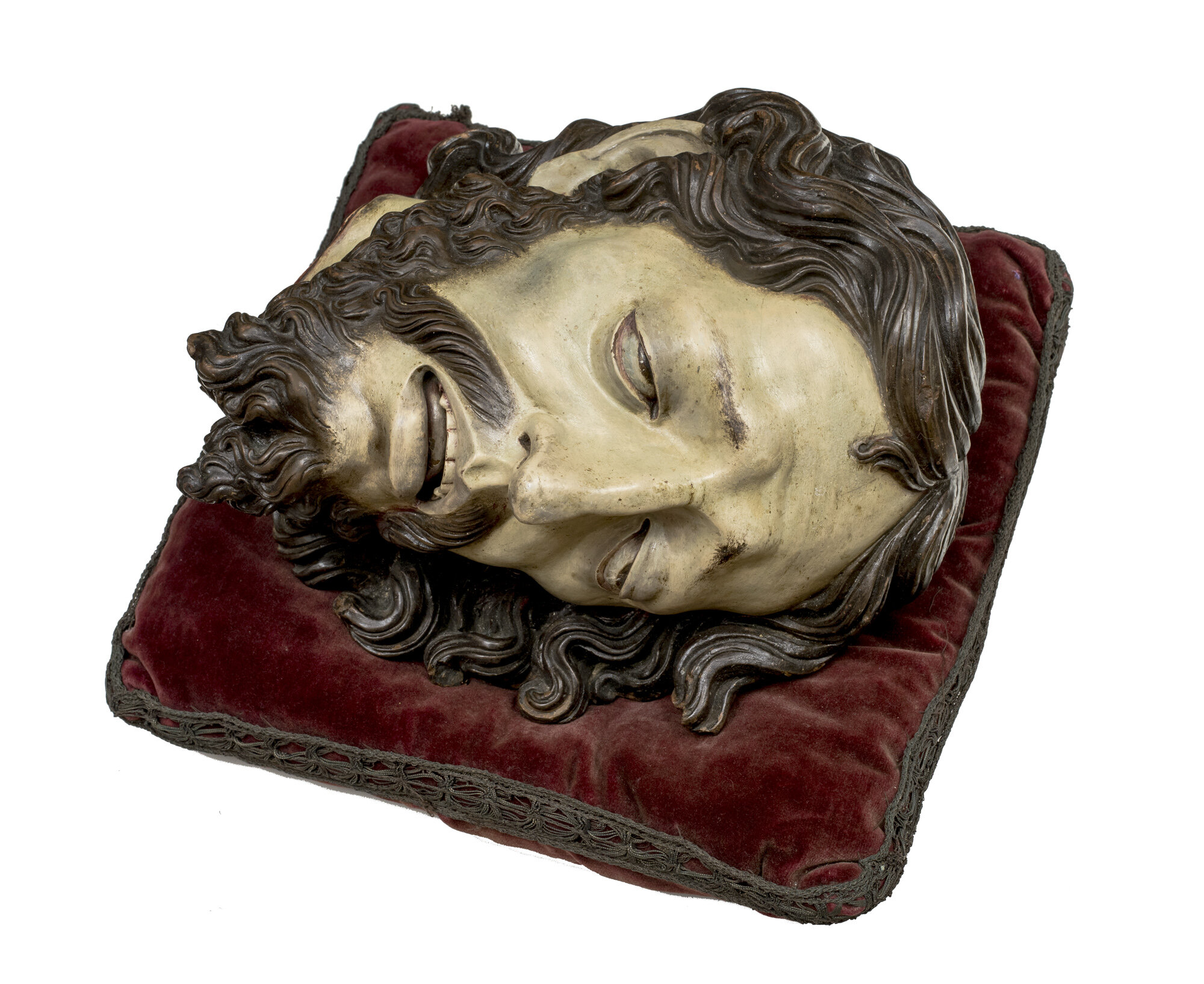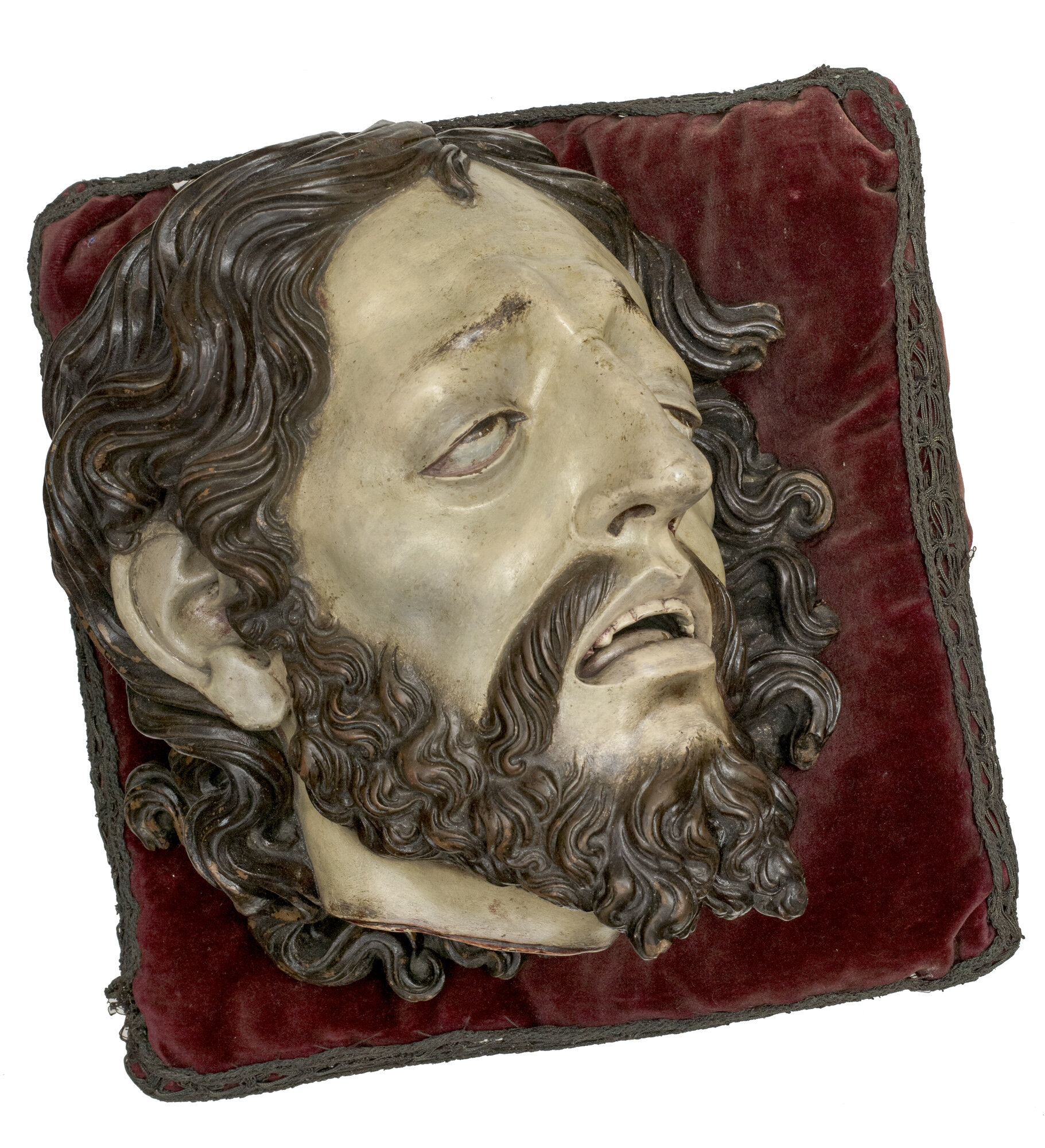JOSÉ DE MORA
(Baza 1642 – 1724 Granada)
Head of Saint John the Baptist
Polychrome terracota
11 7/8 x 9 ½ inches (30 x 24 cm)
Provenance:
Villaverde Collection, Uruguay
Exhibited:
Lust der Täuschung; Von antiker Kunst bis zur Virtual Reality, Kunsthalle Munich, 17 August 2018 – 13 January 2019, exh. cat., Munich, 2018, p. 82 ill.
This dramatic rendering in terracota of the severed head of Saint John the Baptist is an outstanding example of the hyper-realistic polychrome sculpture of the Spanish Golden Age. Its graphic depiction of the martyred saint by one of the preeminent sculptors of the period was intended to stimulate the piety and devotion of the faithful observer. While the image was meant to inspire religious devotion, its visceral impact today elicits broader, but no less powerful responses.
Álvaro Pascual Chenel has written of the present work:
Images of the severed heads of Saint John the Baptist and Saint Paul had notable success in the Counter-Reformist environment of Spain—especially sculpted images, due to the greater impact caused by the strong realism of three-dimensional images. This was precisely the effect sought by the Counter-Reformation through the celebrated decree concerning sacred images: to move, persuade, convince, thrill and incite piety and devotion through images, although sometimes with the consequence that the realism and drama were taken to extremes. Art was intended to be in the service of the Church, effectively transmitting a doctrinal message. This type of graphic image of raw realism should be seen in the context of the cult of martyrs, encouraged and stimulated by the Counter-Reformation in opposition to the tenets of the Protestant movement. The figure of Saint John the Baptist had notable success and inspired extreme devotion as it embodied the tenets of the post-Tridentine Church. John was a forerunner of Christ—an ascetic, penitent and preacher—the last of the prophets and the first martyr, which made him a paradigm of the values and triumphant spirit of the Church of the Counter-Reformation.
For this reason the iconography of John the Baptist was broadly disseminated in Baroque art, in painting as well as in sculpture, drawing upon representations that had been employed since medieval times. In these the most significant moment in his biography is the bloody event of his martyrdom, charged with profound drama that is emphasized by the favorite iconographic manifestation: the explicit depiction of the severed head of Saint John, isolated from the rest of the story of Salome, placed on a silver tray and in the foreground. These representations of horrifying reality put to the test the skills and expertise of sculptors causing, even today, a striking impression. These heads were usually intended for intimate devotion in private chapels.
As stated above, particularly expressive examples are to be found mostly in sculpture, in wood as well as in terracotta. An indicator of the success and wide dissemination of the subject are the many works of this kind that can be found from the 16th Century on in the Castillian and Andalusian schools, which continued on into the 18th century. Some of the Castillian creations from the Renaissance worthy of mention are the examples of heads of the Baptist by Juan de Juni from the Museum of the Cathedral in Valladolid, (ca. 1545) and the one by Andrés de Rada (ca. 1579) in the Church of San Quirce in Valladolid. From the height of the Baroque, although already in the beginning of the 18th Century, is the Head of Saint Paul by Juan Alonso Villabrille y Ron (1707) at the National Sculpture Museum, perhaps the masterpiece of this type of gory representations. Also important are the various known examples of heads of both Saint Paul as well as Saint John the Baptist by the hand of Felipe de Espinabete dating from the second half of the 18th Century.
It is, however, to the Andalusian school between the 17th and 18th centuries that the present work can be related, and more precisely to the school of Granada and the circle of the Moras—an environment that would have such strong significance to the sculptor-painter Alonso Cano. The first Andalusian representations of this type are those by Gaspar Núñez Delgado, with his Head of the Baptist from 1591 (Fine Arts Museum of Seville) and the magnificent carving by Juan de Mesa of ca. 1625 from Seville Cathedral. Much closer in style and concept to the present work are the various interpretations of the same subject by Torcuato Ruiz del Peral (1708-1773), dated in the mid-18th Century. Together with José Risueño, they are the two most important sculptors in the Baroque school of sculpture from Granada, in the transition period between the 17th and 18th centuries, who would extend the aesthetics and models learned from their common master José de Mora. Both would create some of their highest quality works in terracotta. In fact, several works have alternated in attribution between José and Diego de Mora and vice versa.
The various examples of decapitated heads by Ruiz del Peral and some of the most important works by his master José de Mora offer a valuable comparative pattern that make possible to establish a plausible stylistic attribution. As for Ruiz del Peral, some of his works that should be mentioned here are the heads of Saint John the Baptist from the National Sculpture Museum, one in terracotta and one in wood, dated between 1740-1750, as well as the ones in the Granada Cathedral and in the chapel of San Felipe Neri in Cádiz, also made in wood and terracotta respectively. The technical and stylistic similarities and close aesthetic values are evident when compared to the object of the present study.
As can be seen in the works by Ruiz del Peral, the modeling of the present head shows high technical quality. The anatomical characteristics are very similar, showing a highly specific gaunt face of strong, defined elongated features. His cheeks are sunken and have prominent cheekbones. The superorbital ridge is also quite emphasized, with eyebrows describing a characteristic arch that frames the sunken eye sockets. His eyes are shown rolled back, swollen, with droopy eyelids and slightly open with a completely lost gaze, as would be correspond to such a violent death. The nose is straight and sharp and has a prominent bridge. The half-open mouth exhaling his last breath shows his modeled teeth and tongue. The transmission of tragic emotions is achieved by means of a careful polychromy that reflects the ghastly paleness of his gaunt and emaciated face. Some details contribute to increase the realism of the representation, like the bruises on the cheekbones and lips, or the pinkish tones in the sockets of his eyes, as well as the stains and trickles of blood on the neck, between the teeth, on the ear and the temple on which lies the head.
However, in spite of the undeniable proximity to the heads by Ruiz del Peral, the work studied here transmits a pathos, a spirit that is filled with something different that leads us to suggest an affiliation with José de Mora. In fact, Ruiz del Peral is a direct heir of José de Mora, from whom many of the models he used derived. Some of the previously mentioned physiognomic features that are so defined in this head are practically coincident with the typologies that are typical of the works by José de Mora, even more emphasized in his final period, after the death of his wife. In this sense, we will mention a few works that allow establishing comparative elements, like the famous Christ of Mercy of the church of Saint Joseph in Granada of ca. 1695; the Ecce Homo from the National Sculpture Museum; the Saint Pantaleon from the Church of Saint Ana in Granada, from his final period; Christ gathering his robes, from the Church of El Salvador in Granada, lost in the Civil War; the spectacular Christ gathering his robes, recently on the art market, attributed to the brothers José and Diego de Mora; or the Saint Francis from the Cathedral of Cordoba (towards 1700). A few other works attributed to him could be added, like the groups of the Virgen de las Angustias (Our Lady of Sorrows) from the Jaén Cathedral (towards 1690) or the Christ of the Sentence.




